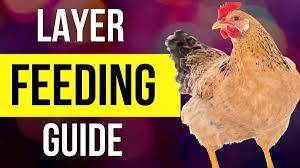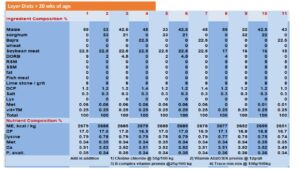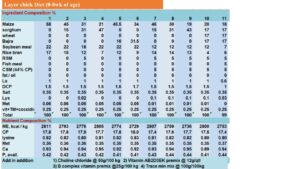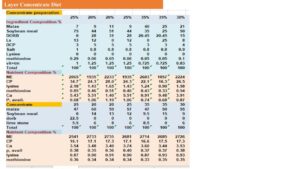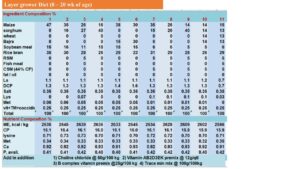How to increase feed intake in commercial layer for optimum production
Feed consumption and its efficient utilization is one of the major concerns in commercial table egg production as feed cost is one of the major components of total cost of production. Feed alone may contribute from 60 to70% to the total cost of production in egg type layers). Better utilization of feed and avoiding unnecessary feed wastage could be the leading factors in minimizing total cost of production . A layer requires 2.5 kg of feed for 1 kg eggs produced .Elwardany et al (1998) reported a daily feed intake of 102 g over a 52 weeks production period and 2.07 kg feed/dozen eggs laid. Petek (1999) reported a daily feed consumption/layer (115 g).
Feed consumption is a variable phenomenon and is influenced by several factors such as strain of the bird, energy content of the diet, ambient temperature, density of birds in the shed, hygienic conditions and rearing environment. When feed quality and house temperature were maintained constant, an increased density of birds increased feed intake/dozen eggs by 68 g/bird . Carey et al (1995) also reported an increase in feed consumption in overcrowded houses. Zahir-ud-Din et al (2001) reported poor feed efficiency of chickens in overcrowded houses under poor hygienic conditions. Moorthy et al (2000) reported better efficiency of feed consumed by egg type layers kept in cages in India than those kept on deep litter. Anderson and Adams (1994) also reported higher feed consumption per bird among egg type layers maintained on the floor than those kept in cages.
When layers are kept in production for 100 weeks instead of 60 or 80 weeks, egg output and associated export of nutrients is much higher. Egg mass, and therefore also yolk output, increase enormously, as is the case with egg shell and the calcium in it. High performing birds need a perfect feeding strategy to maintain the desired performance levels.
Layer chicken are generally reared in three phases viz. starter (0-8 weeks of age), grower (8-20 weeks of age) and layer (20 weeks or above). For meeting the nutrient requirement, particularly that of calcium at onset of lay, pre-lay phase (17/18 – 20 weeks) is recommended. The laying phase is often divided into phase I (20-30 weeks) and phase II (30-45 weeks) and phase III (> 45 weeks). Nutrition and feeding in early part of life influence subsequent laying performance. Modern layers attain sexual maturity (point of lay) at little earlier age (16 wk) as a result the birds produce 310-325 eggs per year. The critical nutrients required for optimum laying performance are energy and protein (amino acids). The energy concentration ranges from 2600 to 2850 kcal/kg during starting, 2500-2900 kcal per kg during growing and 2500 to 2800kcal/kg diet during laying phases. Similarly the requirements of protein for the corresponding phases are 18-20%, 15 to 16% and 15 to 18%. Birds can satisfy energy intake by adjusting their daily feed intake (100-110 g/d/b); however, they are unable to meet their amino acid needs by adjusting feed intake.
Nutrient intake
The actual nutrient intake in gram nutrient per hen per day is a result of the diet composition (feed formulation) and the feed intake level (feed consumption). The actual nutrient intake should match the nutrient requirements in all stages of birds’ development: growth, growth combined with (start of) production, only production. Besides growth and/or production, nutrients are always needed for maintenance. Nutrient requirement is also influenced by production level of egg mass, which is a result of egg weight and deposition. In the period 18-35 weeks of age, birds are still growing and therefore need nutrients and energy for growth, next to their standard needs for maintenance. As birds also come into production in this period, nutrients and energy are needed for egg production as well. Unfortunately in the period 18-25 weeks, feed intake capacity is still limited and might not cover the nutritional and energy requirement which results in a deficiency. Other factors which can lead to a deficiency is when daily feed intake is low due to high environmental temperatures. In these situations an additional midnight feeding can be offered to the birds in order to increase daily feed intake. If daily feed intake is to low, also check water intake level. Too strong restriction on water intake or water with flavor deviation due to pollution can result in lower feed intake, which can result in lower egg weights and finally lower egg mass produced. A situation of low feed intake resulting in a nutrient and energy deficiency at start of lay, can have an impact on the whole production cycle by, for example, lower production in terms of lower laying rate and egg weights, increased mortality, and reduced egg shell quality. Therefore always check nutrient requirements with actual feed intake level, because: nutrient intake = diet composition x feed intake.
Amino acid requirement
Requirements for amino acids can be expressed in ideal amino acid profiles (defined as a percentage of lysine) or in mg amino acids per gram of egg produced. Actually, three different stages and corresponding ideal amino acid profiles can be distinguished: growth, growth combined with (start of) egg production, and egg production. Although all essential amino acids could be a limiting factor, lysine is the most commonly observed limiting factor for growth because development of muscle mass is at high level, while it is methionine during egg production. At the start of egg production, feed intake capacity is still limited and might not cover the nutritional requirements for amino acids which results in a deficiency.Therefore amino acid levels should be adjusted towards actual feed consumption observed and egg mass produced. Later on in the production cycle, requirements for e.g. digestible methionine reduce with approximately 12% from 60 weeks towards 90 weeks of age. However, birds within the same flock will differ in their production performance level and consequently show variety in their requirements for methionine. This stretches the approach that later on in the production cycle, after growth has been finished (approximately 30-35 weeks of age), amino acid levels should be determined based on daily egg mass produced (deposition and egg weight) and not on the age of the birds. Another important fact to take into account is that the ‘average laying rate in percentage’ does not match individual performances and it could be that two thirds of the flock performs above this average. If the average laying rate is used to estimate the daily amino acid requirements, this can lead to an underestimation of the actual requirements of most of the birds. Because of differences between birds in performance, nutritional requirements have to take into account flock uniformity by feeding and managing the weakest birds while allowing the best birds to produce at their genetic potential. This can be achieved by respecting a safety margin for the inclusion of digestible amino acids in a situation where uniformity is low. If levels of digestible amino acids are set above theoretical concentration (+5%) excellent results can be achieved. To conclude, provide enough amino acids (take daily egg mass and actual feed intake into account), keep flock uniformity in mind and provide amino acids above theoretical requirement for excellent results.
Energy requirements
Energy requirements are determined by maintenance (body weight, feathering, temperature regulation, and activity), egg production, and growth. As mentioned before, three stages of birds’ development during lay which influence the requirements are: growth, growth and production, only production. The energy consumption is determined by energy feed concentration, feed presentation, and feed distribution/management. There is a relation between feed consumption and metabolisable energy intake as layers adjust their feed consumption according to the energy concentration in the diet. However, this regulation mechanism is not perfect and a higher concentration of metabolisable energy (in Kcal/kg) leads to a higher energy intake (in Kcal/day/animal) even though the daily feed consumption (in gram per day) is reduced due to an increase in metabolisable energy concentration. As with other nutrients, energy intake is challenging in the period of start of lay where feed intake capacity is still low and requirements are high due to growth and start of production. Therefore, at onset of lay the priority is to reach adult body weight to obtain a good persistency in lay during the cycle. To achieve this, a feed high in metabolisable energy is needed, higher than the diets provided later on in the cycle. If birds still struggle with gaining enough body weight at start of lay, energy content could be increased by an additional 50-100Kcal/kg. After reaching the adult body weight and egg weights have reached a desirable level, energy levels can be lowered towards the end of the cycle. The objective in this feeding program of adult birds is to avoid birds getting fat. Prevention of fat birds by lowering energy levels and controlling energy intake can be achieved by increasing the fibre content in the diet towards, for example, 7%. When insoluble fibres, like oat hulls, are used especially in a coarse form, improvement of liveability can be expected. For a good energy management, frequent monitoring of feed intake and body weights is essential. Thus, control the birds’ energy balance by respecting the amount of energy needed for growth, performance and maintenance. Furthermore, lower energy levels towards the end of cycle and control feed consumption by adding insoluble fibres (like oat hulls) to the diet in order to be successful in a longer production cycle of 90-100 weeks.
Liver health
The liver is considered to be the key organ for birds in a long production cycle when birds are producing eggs for 90-100 weeks. The reason for this is the influence of the liver and its health and functioning on egg weight, laying rate, persistency in lay, egg shell quality, mortality, and feed conversion. The older birds become the more egg mass they have produced and the more challenging it is for the liver to keep healthy. The main challenge is the omnipresent risk of developing a fatty liver, as predisposing factors are frequently present in current commercial egg production circumstances. The source in which the energy is provided to the birds has an effect on the liver. From a metabolic point of view the formation of lipoprotein with lipids (fat) is efficient and easy for the liver, while energy from proteins and carbohydrates/starch is more taxing for the liver. Therefore a diet rich in fat helps to keep the liver healthy. Other very common predisposing factors seen in situations with production issues as a result of fatty livers are high temperatures, high energy intake, corn diets, fat birds, and cage housing systems. A fatty liver is in malfunction and birds will drop their production performance.
Furthermore, liver health is linked to egg shell quality through the metabolism of vitamin D. Egg shell quality deteriorates when the liver is less efficient in activating vitamin D3 which is necessary for calcium transportation to the egg gland. Nutritional factors that are able to stimulate the recovery of the liver and also able to prevent issues with fatty livers are diets high in fat instead of high in carbohydrates and the inclusion of choline, vitamin B12, folic acid, and vitamin E. Choline is highly effective and present in a wide variety of raw materials, like in soybean meal and rapeseed meal, although availability of choline in rapeseed meal is low. Wheat and corn also contain choline and higher concentrations are seen in wheat compared to corn. Although choline is present in quite a variety of raw materials, supplementary choline is always beneficial for the birds in production and therefore must be included in layer diets. Several factors determine the amount of added choline which is needed. The main factors are raw material selection, length of production period, and the desired safety margins as part of risk management. In situations of increased incidence start supplementing choline at 18 weeks of age. Advised added choline levels in the layer feed are 500 1000ppm, with 250ppm as an absolute minimum. Maintain hens’ capital throughout a longer production cycle by focusing on liver health and preventing the development of a fatty liver by providing energy from fat instead of energy from carbohydrates and by supplementation with sufficient amounts of choline.
Mineral supply
The rearing period is the most important factor for preparing the bird for the laying period. Skeletal development is finished for 95% around 11 weeks of age and when birds come into production calcium availability is again very important. An early flock must receive a pre-layer diet in order to meet calcium requirements, and a good and safe strategy is to start with the pre-layer diet at two weeks before the first egg is expected and continue up to 2% of lay at latest. At the start of lay calcium export to the egg is 1.9g. When birds receive an average developer diet, only 0.9g of calcium is offered via the feed. This situation will result in decalcification and transport from calcium from the bones towards the egg shell. In order to obtain a robust medullary bone, decalcification should be prevented. During egg production there is no big difference in mineral requirement between younger and old birds. However calcium source becomes even more important towards the end of the cycle. Calcium source should be coarse (2-4mm) and slowly soluble to extend the period of calcium absorption from the feed in the intestinal tract and thereby lower the level of decalcification from bones, which will also improve egg shell quality. Therefore, make sure calcium supply is at the correct level especially at the end of the rearing period (pre-layer diet) to minimize bone decalcification in order to achieve a robust medullary bone and provide coarse, slowly dissolving calcium during egg production.
Feeding technique
There is a strong relation between the applied feeding technique and mineral dynamics. Although calcium requirements will not be dramatically different for birds in longer production cycles, adaptations in management by adjusting the feeding technique have been shown to be beneficial. For maintaining good egg shell quality, the feeding technique seems to be more important than the actual nutrition in birds at the end of a longer production cycle. The objective for changing the feeding technique is to provide calcium from the feed at the moment of calcification of the egg shell. In this way the use of calcium from the feed is maximised, while minimising the mobilisation of calcium from the bones. The details of the recommended feeding technique are as follows: provide a morning feed (40% of the amount of feed), make sure feeders are empty at the middle of the day (for 1.0-1.5 hours in order to increase feed consumed at the end of the day), perform an afternoon feeding during 6 or 7 hours before light off moment (60% of the amount of feed), if possible include a midnight feed (1 -2 hours of light starting at 3.5 hours after light off moment). If possible in the daily operation, apply the concept of split feeding where two different diets are provided within a day. Split feeding enables the birds to meet their specific requirements, which results in a higher uptake of energy and amino acids in the morning, while in the afternoon calcium uptake is higher. This supply of nutrients fit the requirement for egg formation better and generally results in improved egg shell quality. In a long production cycle the moment of nutrients available is crucial for maintaining performance and therefore provide calcium at the moment of calcification.
FEEDING METHODS OF LAYERS AND BROILERS
Compiled & Shared by- Team, LITD (Livestock Institute of Training & Development)
Image-Courtesy-Google
Reference-On Request.
HOW TO MAKE LAYER FEED FOR A LONGER PRODUCTION CYCLE AND HIGH PERFORMANCE



